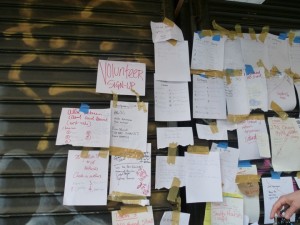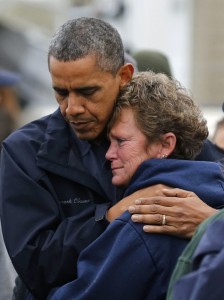Unsettling Report on Last-Minute Installation of New Vote Reporting Software in Ohio
Tuesday Update: The AP’s reporting today that U.S District Court Judge Gregory Frost has refused to hear the lawsuit brought by Ohioans Bob Fitrakis and Gerry Bello over the last-minute installation of new vote reporting software by Secretary of State Jon Husted. Husted’s conduct throughout the campaign has been despicable.
—
Evening Update: TheBradBlog’s post, which I’d linked to earlier today, has been cross-published in Salon.com. I’m glad to see this puzzling matter of Ohio Secretary of State Jon Husted’s installation of new vote reporting software getting noticed before voting day tomorrow.
—
Just saw this tweet from indie journalist Dan Gillmor alerting his followers to this post on the Brad blog about a new piece of software that Ohio Secretary of State John Husted has installed very recently into Ohio’s vote tabulating system. I quickly retweeted Gillmor’s tweet. Here are the first eight paragraphs from Brad Friedman’s post, with links to earlier reporting on this story:
to this post on the Brad blog about a new piece of software that Ohio Secretary of State John Husted has installed very recently into Ohio’s vote tabulating system. I quickly retweeted Gillmor’s tweet. Here are the first eight paragraphs from Brad Friedman’s post, with links to earlier reporting on this story:
“Last week, Bob Fitrakis and Gerry Bello at FreePress.org reported an important story concerning what they described as “uncertified ‘experimental’ software patches” being installed at the last minute on electronic vote tabulation systems in 39 Ohio counties.
The story included a copy of the contract [PDF] between Republican Ohio Sec. of State Jon Husted’s office and ES&S, the nation’s largest e-voting system manufacturer, for a new, last minute piece of software created to the custom specifications of the Sec. of State. The contract itself describes the software as ‘High-level enhancements to ES&S’ election reporting software that extend beyond the current features and functionality of the software to facilitate a custom-developed State Election Results Reporting File.’
A subsequent story at The Free Press the following day included text said to be from a November 1 memo sent from the OH SoS Election Counsel Brandi Laser Seske to a number of state election officials confirming the use of the new, uncertified software on Ohio’s tabulator systems. The memo claims that ‘its function is to aid in the reporting of results” by converting them “into a format that can be read by the Secretary of State’s election night reporting system.’
On Friday evening, at Huffington Post, journalist Art Levine followed up with a piece that, among other things, advanced the story by breaking the news that Fitrakis and his attorney Cliff Arnebeck were filing a lawsuit for an immediate injunction against Husted and ES&S to ‘halt the use of secretly installed, unauthorized ‘experimental’ software in 39 counties’ tabulators’. Levine also reported that Arnebeck had referred the matter to the Cincinnati FBI for criminal investigation of what the Ohio attorney describes as ‘a flagrant violation of the law.’
‘Before you add new software, you need approval of a state board,’ says Arnebeck. ‘They are installing an uncertified, suspect software patch that interfaces between the county’s vote tabulation equipment and state tabulators.’ Arnebeck’s alarm is understandable.
Since the story initially broke, I’ve been trying to learn as much as I could about what is actually going on here. During that time, a few in the mainstream media have gotten wind of the story as well, including NBC News and CNN, and have been able to press Husted and other officials in his office into finally responding to the concerns publicly. The Ohio officials have attempted to downplay the concerns, though in doing so, they appear to have given misleading information which, at times, seems to conflict even with the contract itself.
I’ve also spoken to computer scientists and election integrity experts, in trying to make sense of all of this, though many of them seem to be scratching their heads as well. My own queries to the Sec. of State’s office have gone unanswered, as had Fitrakis’ and Bello’s before they published their initial story, begging the question as to why, if this software is as benign as Ohio officials are suggesting, they didn’t respond immediately to say as much. Furthermore, why did they keep the contract a secret? Why did they wait until just before the election to have this work done? And why did they feel it was appropriate to circumvent both federal and state testing and certification programs for the software in the bargain?
And, just to pre-respond to those supposed journalists who have shown a proclivity for reading comprehension issues, let me be clear: No, this does not mean I am charging that there is a conspiracy to rig or steal the Ohio election. While there certainly could be, if there is, I don’t know about it, nor am I charging there is any such conspiracy at this time. The secretive, seemingly extra-legal way in which SoS Husted’s office is going about whatever it is they are trying to do, however, at the very last minute before the election, along with the explanations they’ve given for it to date, and concerns about similar cases in the past, in both Ohio and elsewhere, are certainly cause for any reasonable skeptic or journalist to be suspect and investigate what could be going on. And so I am…”
—
I will be watching for updates on this story, especially the lawsuit filed by Fitrakis and Arnebeck that’s been filed seeking an injunction to prevent use of the new software. The odious Mr. Husted is also in court today, with national DEMs trying to prevent him from enacting an onerous burden on voters who use provisional ballots. A ruling is expected on that before voting day tomorrow.





 Storm damage outside my apartment building has those of my neighbors with cars unable to move them. These are pictures taken at around noon today. Twelve hours later, the fallen tree still bisects my Upper West Side block, and we still have no traffic on our side street between Riverside Drive and West End Avenue. Note how fortuitously these limbs crashed toward the pavement–none of the cars has so much as a scratch or a cracked windshield. Strangely delicate destruction.
Storm damage outside my apartment building has those of my neighbors with cars unable to move them. These are pictures taken at around noon today. Twelve hours later, the fallen tree still bisects my Upper West Side block, and we still have no traffic on our side street between Riverside Drive and West End Avenue. Note how fortuitously these limbs crashed toward the pavement–none of the cars has so much as a scratch or a cracked windshield. Strangely delicate destruction.